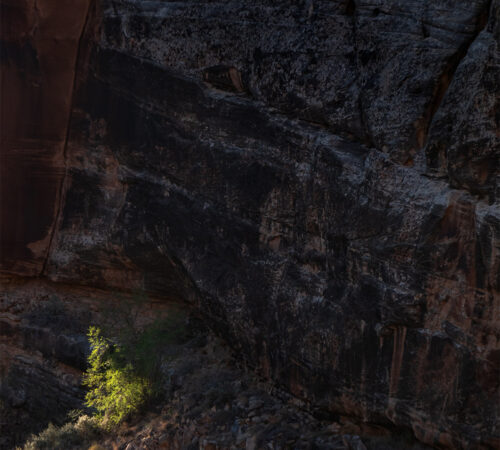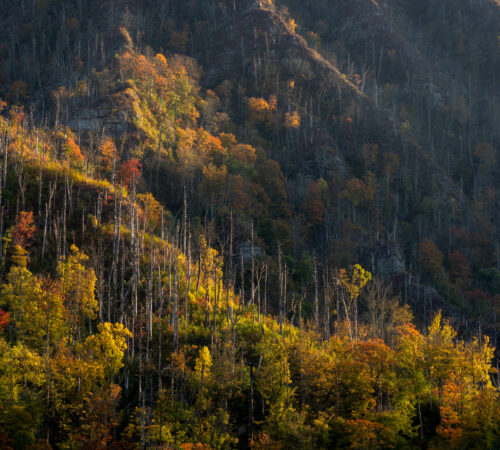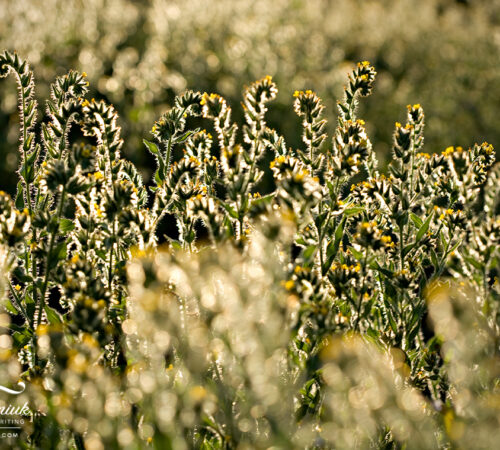What’s Real?

Dear Bubbles:
As a photographer who is reluctant to depart radically from what I see out in nature, I am a bit worried about the flood of artificial intelligence (AI) generated images that look so very graphic but cannot be physically possible (you know the ones: triple rainbows–sometime four, etc.). I worry that the public at large will come to expect this, much as they already have accepted super saturated (gaudy?) colors due to their exposure to this on their super saturated TV sets which becomes reality to them. This would obviously make my photography bland indeed. Or do I follow the lead and put two moons, extra mountains, and all sorts of crazy stuff in, just to be noticed? On another note: Photography has fought hard to even be considered to be an art form. Does all this nonsense jeopardize this?
~Bill
Dear Bill:
Thanks for asking this question in my recent “Ask Me Anything” session on the Nature Photographers Network. (Readers can see this and all the questions/responses from that 24-hour event at https://npn.link/colleenminiuk-ama). I have received similar questions from others but asked in a slightly different way. Hopefully this column will cover those as well. As such, I’ve expanded and refined my answer here from the one I gave on NPN.
My primary concern with artificial intelligence (AI) is how programs steal existing work to create new ones. No prior permission from the original artist is granted. No prior agreement is formed. No credit is provided. No payment is made. It feels like blatant copyright infringement. Right now, photographers (and others) have little control over how our work is utilized in this technology. It’ll be interesting to see how the legal aspect of AI plays out as this technology evolves…but if you’ve posted your images on social media or on the web, AI is likely using your work in some form without your knowledge. Ain’t that special?
Other than that, AI is just another method for creating art. We’ve seen so many different methods evolve to create art over centuries. I care less about how the art gets made, more that it just does.
The AI discussion does beg the question, though, who—or what—really makes a photograph? You and I turn some knobs on a camera. Press some buttons. Click the shutter. But there’s software and hardware involved to bring that image to life. We’ve been using technology to create images since Steve Sasson invented the digital camera in 1975. It’s essentially a small, hand-held computer now.
Plus, if you’ve used processing software, you’ve already used AI and reaped the benefits. Have you used the Clone Stamp function to remove dust? Changed the white balance? Used Content Aware Fill to fill an expanded frame? Is that all “artificial?” I could make an argument that it is.
Does the fact that I used Denoise, the Remove tool, and the Warp tool—all AI-based functions—on the photograph at the top of the frame disqualify it as a photograph? Make it less real?
What about combining images in Photoshop? One could argue blending two or more frames to create a single image is the same concept as AI. You sit at a computer, select outside materials, and a program combines those images to create a new image. In an AI generated image, a person enters prompts, and a program creates that final image. Does who or what generates the photograph define a photograph?
Remember we had a similar philosophical dilemma when digital single-lens-reflex cameras (DSLRs) hit the scene—is a digital file really a photograph? Is a slide or negative or glass plate any more, or less, a photograph than a digital file or a print? No matter the material or product, fundamentally, we’re still using light to create a picture. The tools and methods to accomplish it just continue to evolve. AI is “just” another tool and method.
Where I see people getting hung up on AI is that they feel AI is lying to them, that an image created by AI isn’t real or the truth. It’s not, but neither is a photograph. The problem isn’t AI. The problem is that a fair amount of the population, photographers or not, believe that photographs are real and/or should depict a reality or truth. There is no shared reality, no shared truth in anything in this world, but especially in photographs.
The second I set up a frame, even a “straight” single exposure, it’s not telling a full truth. I’ve eliminated things in the landscape by positioning myself relative to the subject. I’ve changed the apparent form of waves by slowing my shutter speed and using filters. I’ve enhanced the focus on a visual element like a flower by using selective depth of field. Even in the film days, photographers manipulated tones, combined slides, and used filters in the darkroom in the same way we do today in processing software. Does that make our photographs fake?
(OK, we might be able to come to a shared understanding about some things…like having two moons in our sky…)
Here’s the thing, you and I could stand in the same place and not see the same thing at all because of our backgrounds, expectations, mental capacity, etc. A case in point: a few years ago, I was judging a photography contest. One submission in the category for “Green” was of a leaf. I viewed it as a shade of teal and thus disqualified it. My fellow judge saw it as grass green and an excellent discussion followed. What is real here? What’s the real color? Who is telling the truth? Who gets to define what’s real? Telling me it is green does not make me see green or believe the leaf was green. In this situation, both of our experiences are real and truthful. To us. Even if we cannot come to a shared understanding.
By the way, I trusted my fellow judge—and the contestant to enter a green photo in a Green category—and reversed my decision. The experience was still eye-opening to me in learning that I see color, especially blues and greens, quite differently than most. This was later confirmed when I presented what I wholeheartedly believed was an image of a blue and yellow wave on a webinar with Ian Plant, only to find out he and most of the audience watching saw the wave as green and yellow. Good times!
Anyhow! If I make an image of a leaf and increase the blues to match what I experience in the world, am I lying? I’m not, if my world is to be trusted. But others might believe I’m tricking them or manipulating them. I’m not. My world just differs from everyone else’s. In the same way your world just differs from everyone else’s, and everyone’s else’s world differs from everyone else’s. What is real and truthful is defined by an individual.
I get it, people don’t want to feel duped. In writing, for example, fiction differs from non-fiction. Should we delineate AI vs. human-made photographs accordingly? Where would we draw that line? Adobe, Intel, Microsoft, BBC, and several other companies, who formed a coalition in February 2021 called the Content Authenticity Initiative. (https://contentauthenticity.org), are working on that answer. They aim to set standards for digital-based media for identifying misinformation. You can test image files using their Verify tool from their website to see how it currently works.
In the meantime, the solution isn’t to stop creating our own art in our own ways that express our own reality and truths so that we can attempt to meet unrealistic societal expectations or an unachievable shared reality. The solution is for people to stop believing everything they see and value photographs, however they are created, for what they are: artistic interpretations and self-expressions.
The progression and increasing popularity of AI gives us a great opportunity to stop and think about why we photograph in the first place. Because you love the experience of being outside? Or because you love sitting behind a computer letting a program produce random things? Or because you want to put two moons, extra mountains, and all sorts of crazy stuff in your frame? Or because you want to be noticed?
I know my answer. No amount of AI could ever take away the awe and wonder I feel when I’m on a standup paddleboarding on a river or standing on a coastline or frolicking in a field of flowers. Those experiences enrich my life with or without a camera. That’s what’s real to me.
No machine or technology can replace my desire and ability to connect with nature; or recreate the emotional responses I have while hiking or paddling; or come up with the stories I do in my imagination; or celebrate the memory of some magical moment. No machine or technology can replace the challenges and excitement of the process of making a photograph out of all of that. No machine or technology can know and interpret my life better than I know my own.
Self-expression depends on the self. That’s the beauty of art comes in for me. The ability to catch a glimpse of a human’s spirit and soul in outward form. I specifically want to see how YOU see the world I think I see because it expands my understanding of this world.
We can–and do!–all see and express different things, and they all be right answers. If other people want to saturate their images to 100, so be it. If others want to use HDR for all their images, so be it. If others want to use AI to create their art, so be it. It doesn’t mean you or I have to. (And I won’t use be using AI as the basis for creating my art anytime soon.) I may have my own opinion about an approach based on my own preferences, but I’m not going to judge others negatively simply because their methods and interests differ from my own.
As technology continues to challenge , it becomes even more essential that you stay true to your own nature. I’ll follow my curiosities and passions. You follow yours. Create YOUR art for any reason that’s meaningful to you in any way you wish.
If you wish to sit at a computer and create AI-generated images with your time. Awesome! Go for it! Have a blast! I’m not going to stress about how others decide to create their art. It’s a colossal waste of precious time. It takes up way too much mental energy I could otherwise be putting toward creating my own work.
In that same vein, I don’t spend any time evaluating whether photography is an art form or not—with or without AI. While people on the internet fight about whether photography is an art form or not and whether AI jeopardizes that answer, I’m outside practicing photography as a form of expression and joy regardless of what society thinks of it because it brings me much fulfillment. I couldn’t care less what other people think about that or how they label that.
Sure, if you want to have healthy debate about this topic around a campfire, I’m game. But the answers won’t and don’t affect how I live my life. If I said photography IS an art form, would you stop photographing? No, of course not! If I proclaimed photography is NOT an art form, would you stop photographing? I sure wouldn’t. Who cares whether it is or isn’t?
What if we said AI will absolutely and unequivocally affect the public’s perception of photography. Are you going to stop going outside and making images? I’m not. In fact, that only makes me want to go outside and photograph more to ensure the human experience and man-made images are celebrated and do not lose their place among so-called progress.
What if we said you’ll never get another like on Facebook for your images. Are you going to stop going outside and making images now? Please read my column about this called “If No One Saw Your Photos” for more on this topic.
What the public expects on TV sets, the number of moons, and photography in general is based on their own experiences and own interests. We cannot control how other people respond to our images. In fact, I like to bastardize an Eleanor Roosevelt quote: “What other people think of your photographs is none of your business.” Worrying about the public response to your work isn’t a good use of your time. And making images solely to appease public opinion isn’t either.
Making photographs you’re proud of for the reasons you do is a great use of your time. Connecting with people who value your human-made work is a great use of your time. Doing whatever you wish with your one shot at life is a great use of your time. So choose wisely. Choose what makes sense to you. Choose yourself. Because that’s the only thing that’s real.
Be well, be brave, be wild,
Bubbles
If you liked this post and others like it, please consider supporting Dear Bubbles either through a monthly contribution through Patreon or a one-time donation through Buy Me a Coffee. Learn more about both at https://dearbubbles.com/support.
Have a question about photography, art, and/or the creative life? Need some advice? Looking for inspiration? Send your question to Dear Bubbles at colleen@colleenminiuk.com to be possibly featured in a future column post. (If you’d prefer a different display name than your real first name, please include your preferred nickname in your note.





2 Comments
Barbara Canney
I have the same question about Ai. I agree with your viewpoint about being outside in nature and photographing what you see and feel. Sitting at a computer is not my forte except to clean up, fine tune my images.
Thats said I also just started playing with snapseed and colorarama on my phone. Having fun messing around and then realizing OMG I love it. I got two of them in shows. I think viewers are happy to see something “newer with a fresh eye.”
Toni Francis
I love how you presented this topic!
I had never messed with an image before the Grand Canyon trip. LOL
As I used my phone for photos, saving my big girl camera battery, I found the alternate styles to my liking. I’m not big on selfies, yet the drawing app gave an image of self that resonates with my soul.
AI has shown me what others see when they draw. A new awareness.
I love learning! Still love to capture that special moment and it needs no help to enhance.